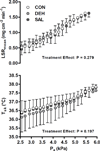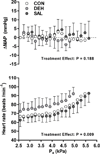Does attenuated skin blood flow lower sweat rate and the critical environmental limit for heat balance during severe heat exposure?
- PMID: 27859929
- PMCID: PMC5288282
- DOI: 10.1113/EP085915
Does attenuated skin blood flow lower sweat rate and the critical environmental limit for heat balance during severe heat exposure?
Abstract
What is the central question of this study? Does attenuated skin blood flow diminish sweating and reduce the critical environmental limit for heat balance, which indicates maximal heat loss potential, during severe heat stress? What is the main finding and its importance? Isosmotic hypovolaemia attenuated skin blood flow by ∼20% but did not result in different sweating rates, mean skin temperatures or critical environmental limits for heat balance compared with control and volume-infusion treatments, suggesting that the lower levels of skin blood flow commonly observed in aged and diseased populations may not diminish maximal whole-body heat dissipation. Attenuated skin blood flow (SkBF) is often assumed to impair core temperature (Tc ) regulation. Profound pharmacologically induced reductions in SkBF (∼85%) lead to impaired sweating, but whether the smaller attenuations in SkBF (∼20%) more often associated with ageing and certain diseases lead to decrements in sweating and maximal heat loss potential is unknown. Seven healthy men (28 ± 4 years old) completed a 30 min equilibration period at 41°C and a vapour pressure (Pa ) of 2.57 kPa followed by incremental steps in Pa of 0.17 kPa every 6 min to 5.95 kPa. Differences in heat loss potential were assessed by identifying the critical vapour pressure (Pcrit ) at which an upward inflection in Tc occurred. The following three separate treatments elicited changes in plasma volume to achieve three distinct levels of SkBF: control (CON); diuretic-induced isosmotic dehydration to lower SkBF (DEH); and continuous saline infusion to maintain SkBF (SAL). The Tc , mean skin temperature (Tsk ), heart rate, mean laser-Doppler flux (forearm and thigh; LDFmean ), mean local sweat rate (forearm and thigh; LSRmean ) and metabolic rate were measured. In DEH, a 14.2 ± 5.7% lower plasma volume resulted in a ∼20% lower LDFmean in perfusion units (PU) (DEH, 139 ± 23 PU; CON, 176 ± 22 PU; and SAL, 186 ± 22 PU; P = 0.034). However, LSRmean and whole-body sweat losses were unaffected by treatment throughout (P > 0.482). The Pcrit for Tc was similar between treatments (CON, 5.05 ± 0.30 kPa; DEH, 4.93 ± 0.16 kPa; and SAL, 5.12 ± 0.10 kPa; P = 0.166). Furthermore, no differences were observed in the skin-air temperature gradient, metabolic rate or changes in Tc (P > 0.197). In conclusion, a ∼20% reduction in SkBF alters neither sweat rate nor the upper limit for heat loss from the skin during non-encapsulated passive heat stress.
Keywords: core temperature; cutaneous vascular conductance; heat loss potential; heat stress; sweat.
© 2016 The Authors. Experimental Physiology © 2016 The Physiological Society.
Figures






Similar articles
-
Normobaric hypoxia does not alter the critical environmental limits for thermal balance during exercise-heat stress.Exp Physiol. 2021 Jan;106(1):359-369. doi: 10.1113/EP088466. Epub 2020 May 5. Exp Physiol. 2021. PMID: 32190934
-
Nonuniform, age-related decrements in regional sweating and skin blood flow.Am J Physiol Regul Integr Comp Physiol. 2013 Oct 15;305(8):R877-85. doi: 10.1152/ajpregu.00290.2013. Epub 2013 Aug 7. Am J Physiol Regul Integr Comp Physiol. 2013. PMID: 23926135 Free PMC article.
-
Impairments in local heat loss in type 1 diabetes during exercise in the heat.Med Sci Sports Exerc. 2014 Dec;46(12):2224-33. doi: 10.1249/MSS.0000000000000350. Med Sci Sports Exerc. 2014. PMID: 24784146
-
Effects of thermal stress during rest and exercise in the paediatric population.Sports Med. 1998 Apr;25(4):221-40. doi: 10.2165/00007256-199825040-00002. Sports Med. 1998. PMID: 9587181 Review.
-
Neural control and mechanisms of eccrine sweating during heat stress and exercise.J Appl Physiol (1985). 2006 May;100(5):1692-701. doi: 10.1152/japplphysiol.01124.2005. J Appl Physiol (1985). 2006. PMID: 16614366 Review.
Cited by
-
Sustained increases in skin blood flow are not a prerequisite to initiate sweating during passive heat exposure.Am J Physiol Regul Integr Comp Physiol. 2017 Aug 1;313(2):R140-R148. doi: 10.1152/ajpregu.00033.2017. Epub 2017 May 31. Am J Physiol Regul Integr Comp Physiol. 2017. PMID: 28566303 Free PMC article.
-
The effect of prescription and over-the-counter medications on core temperature in adults during heat stress: a systematic review and meta-analysis.EClinicalMedicine. 2024 Oct 24;77:102886. doi: 10.1016/j.eclinm.2024.102886. eCollection 2024 Nov. EClinicalMedicine. 2024. PMID: 39513185 Free PMC article.
-
Thermal strain is greater in the late afternoon than morning during exercise in the gym without airflow and air conditioning on a clear summer day.Front Sports Act Living. 2023 Feb 28;5:1147845. doi: 10.3389/fspor.2023.1147845. eCollection 2023. Front Sports Act Living. 2023. PMID: 36926618 Free PMC article.
-
Stress Response and Safe Driving Time of Bus Drivers in Hot Weather.Int J Environ Res Public Health. 2022 Aug 5;19(15):9662. doi: 10.3390/ijerph19159662. Int J Environ Res Public Health. 2022. PMID: 35955016 Free PMC article.
-
Methods for improving thermal tolerance in military personnel prior to deployment.Mil Med Res. 2020 Nov 29;7(1):58. doi: 10.1186/s40779-020-00287-z. Mil Med Res. 2020. PMID: 33248459 Free PMC article. Review.
References
-
- Anderson RK, Kenney WL. Effect of age on heat-activated sweat gland density and flow during exercise in dry heat. J Appl Physiol. 1987;63:1089–1094. - PubMed
-
- Belding HS, Kamon E. Evaporative coefficients for prediction of safe limits in prolonged exposures to work under hot conditions. Fed Proc. 1973;32:1598–1601. - PubMed
-
- Carberry PA, Shepherd AM, Johnson JM. Resting and maximal forearm skin blood flows are reduced in hypertension. Hypertension. 1992;20:349–355. - PubMed
-
- Cui J, Arbab-Zadeh A, Prasad A, Durand S, Levine BD, Crandall CG. Effects of heat stress on thermoregulatory responses in congestive heart failure patients. Circulation. 2005;112:2286–2292. - PubMed
Publication types
MeSH terms
Grants and funding
LinkOut - more resources
Full Text Sources
Other Literature Sources
Medical

